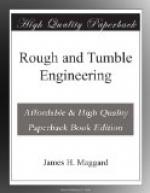Q. How will you find the area of piston?
A. Square the diameter of piston and multiply it
by .7854.
Q. What do you mean by squaring the diameter? A. Multiplying it by itself. If a cylinder is 6 inches in diameter, 36 multiplied by .7854, gives the area in square inches.
Q. What do you mean by average pressure? A. If the pressure on boiler is 60 pounds, and the engine is cutting off at 1/2 stroke, the pressure for the full stroke would be 50 pounds.
Q. Why do you say less 5 pounds?
A. To allow for friction and condensation.
Q. What is the power of a 7 x 10 engine, running 200 revolutions, cutting off at 1/2 stroke with 60 pounds steam? A. 7 x 7 = 49 x .7854 = 38.4846. The average pressure of 60 pounds would be 50 pounds less 5 = 45 pounds; 38-4846 x 45 = 1731.8070 x .333 1/3, (the number of feet the piston travels per minute) 577,269.0000 by 33,000=17 1/2 horse power.
Q. What is a high pressure engine?
A. It is an engine using steam at a high pressure
and
exhausting into the open air.
Q. What is a low pressure engine? A. It is one using steam at a low pressure and exhausting into a condenser, producing a vacuum, the piston being under steam pressure on one side and vacuum on the other.
Q. What class of engines are farm engines?
A. They are high pressure.
Q. Why?
A. They are less complicated and less expensive.
Q. What is the most economical pressure to carry on high pressure engine? A. From 90 to 110 pounds.
Q. Why is high pressure more economical than low pressure? A. Because the loss is greater in low pressure owing to the atmospheric pressure. With 45 pounds steam the pressure from the atmosphere is 15 pounds, or 1/3, leaving only 30 pounds of effective power; while with 90 pounds the atmospheric pressure is only 1-6 of the boiler pressure.
Q. Does it require any more fuel to carry I00 pounds than it does to carry 60 pounds? A. It don’t require quite as much.
Q. If that is the case why not increase the pressure beyond this and save more fuel? A. Because we would soon pass the point of safety in a boiler, and the result would be the loss of life and property.
Q. What do you consider a safe working pressure on a boiler? A. That depends entirely on its diameter. While a boiler of 30 inches in diameter 3/8 inch iron would carry I40 pounds, a boiler of the same thickness 80 inches in diameter would have a safe working pressure of only 50 pounds, which shows that the safe working pressure decreases very rapidly as we increase the diameter of boiler. This is the safe working pressure for single riveted boilers of this diameter. To find the safe working pressure of a double riveted boiler of same diameter multiply the safe pressure of the single riveted by 70, and divide by 56, will give a safe pressure of a double riveted boiler.




